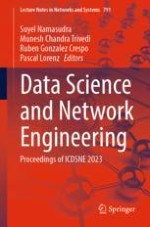This book includes research papers presented at the International Conference on Data Science and Network Engineering (ICDSNE 2023) organized by the Department of Computer Science and Engineering, National Institute of Technology Agartala, Tripura, India, during July 21–22, 2023. It includes research works from researchers, academicians, business executives, and industry professionals for solving real-life problems by using the advancements and applications of data science and network engineering. This book covers many advanced topics, such as artificial intelligence (AI), machine learning (ML), deep learning (DL), computer networks, blockchain, security and privacy, Internet of things (IoT), cloud computing, big data, supply chain management, and many more. Different sections of this book are highly beneficial for the researchers, who are working in the field of data science and network engineering.
